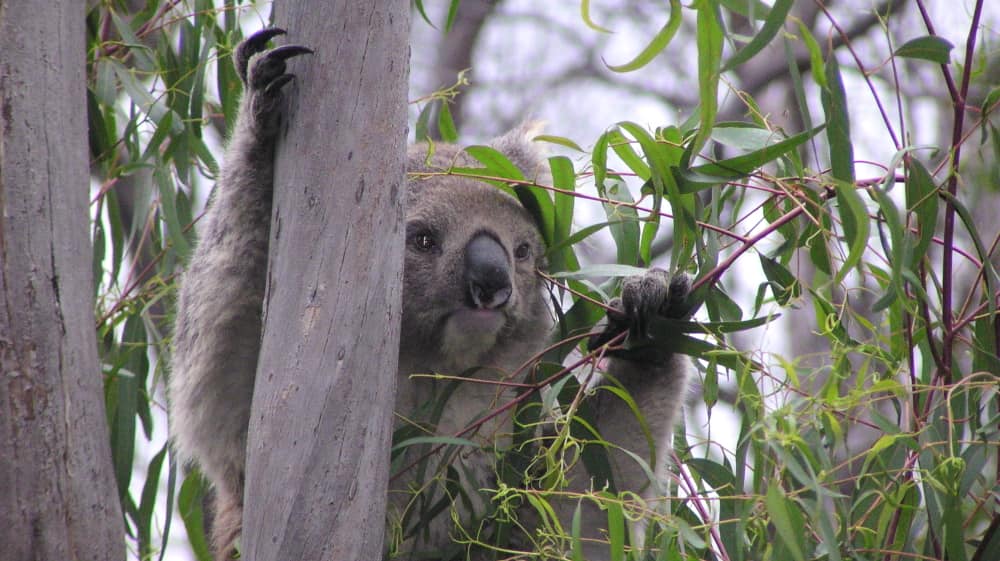We’re getting a lot of requests to plant trees for koalas after the bushfires in burnt areas.
That won’t work.
But tree planting for koalas elsewhere in their range will work.
Let me tell you why…
1. Burnt areas regenerate themselves.
Firstly, after a bush fire, burnt areas usually regenerate themselves. Some eucalyptus trees survive the fire and send out epicormic growth within a few weeks of the fire. *epicormic: shoots from buds under the bark
In the intense Anakie-Brisbane Ranges bushfire of 2006, Red Stringybark Eucalyptus macrorhyncha, Messmate E. obliqua and Broad-leaf Peppermint E. dives, some Manna & Swamp Gums survived and produced their first leaves 4-5 weeks after the fire.
Other eucalyptus trees do not survive above the ground, but their root system lives. They produce lignotuber* growth from the roots that eventually become new trunks of trees. *lignotuber: a woody swelling of the root crown that produces shoots after fire
Some Manna Gum E. viminalis and Swamp Gum E. ovata trunks did not survive the 2006 fire but had new growth from the base within 5 weeks.
Read: What do koalas eat straight after the fire?
After the fire has passed, and rain falls, seed from eucalyptus and wattle trees falls and germinates quickly. The forest becomes very thick, very fast. Within a year of the fire, the forest will be almost too thick to walk through.
It is possible in a very hot bush-fire, that none of the trees or seed have survived. But I’d be surprised. Eucalypts – especially their roots – can survive the most intense fires. However, experts are concerned that regeneration may be slower than normal, due to the drought conditions that preceded this fire season.
Tree planting after bushfire in burnt areas is not recommended or practical in most cases.
2. Some of these fires are in National Parks and on public land.
Most bushfire-affected parks and state forests are closed for weeks or months after the fire. You are not allowed to go into them, at all, unless you are licensed to be there. Don’t be tempted – these places are dangerous, and emergency services have enough to deal with.
Why we should plant trees elsewhere.
With these fires we have lost wildlife, wildlife habitat, and most importantly, carbon storage (1). We urgently need to create complete new forests, to offset the carbon emissions from these fires, to provide habitat for wildlife while the burnt forest recovers, and to store more carbon.
Also, a variety of forest types – riverside linear forests, hilltop forests, wet forests, dry forests – spread across the landscape will protect more wildlife from future fires.
A vast network of tree plantings on private land, all over Australia, could keep our koalas alive in the face of climate change and the fires to come.
Planting trees after these bushfires is the best action to take to ensure koalas have a future.
If you are local to Melbourne & Geelong, join one of our Koala Conservation Days for Locals and help us plant trees or remove weeds. If you are from overseas or interstate, join one of our tours: your contribution ensures that tree planting continues, months after you’ve gone home.
NOTES & REFERENCES:
(1) at a conservative calculation of 200 tonnes of carbon stored per hectare of forest, and a burnt area of 10 million hectares, we have lost around 2billion tonnes of carbon storage in these fires. But I’m no expert on this – hopefully there will be some scientific analysis soon.
The Guardian December 2019: https://www.theguardian.com/environment/2019/dec/13/australias-bushfires-have-emitted-250m-tonnes-of-co2-almost-half-of-countrys-annual-emissions
ABC News December 2019: https://www.abc.net.au/news/2019-12-12/nsw-qld-bushfires-could-increase-carbon-footprint-scientists-say/11789504






